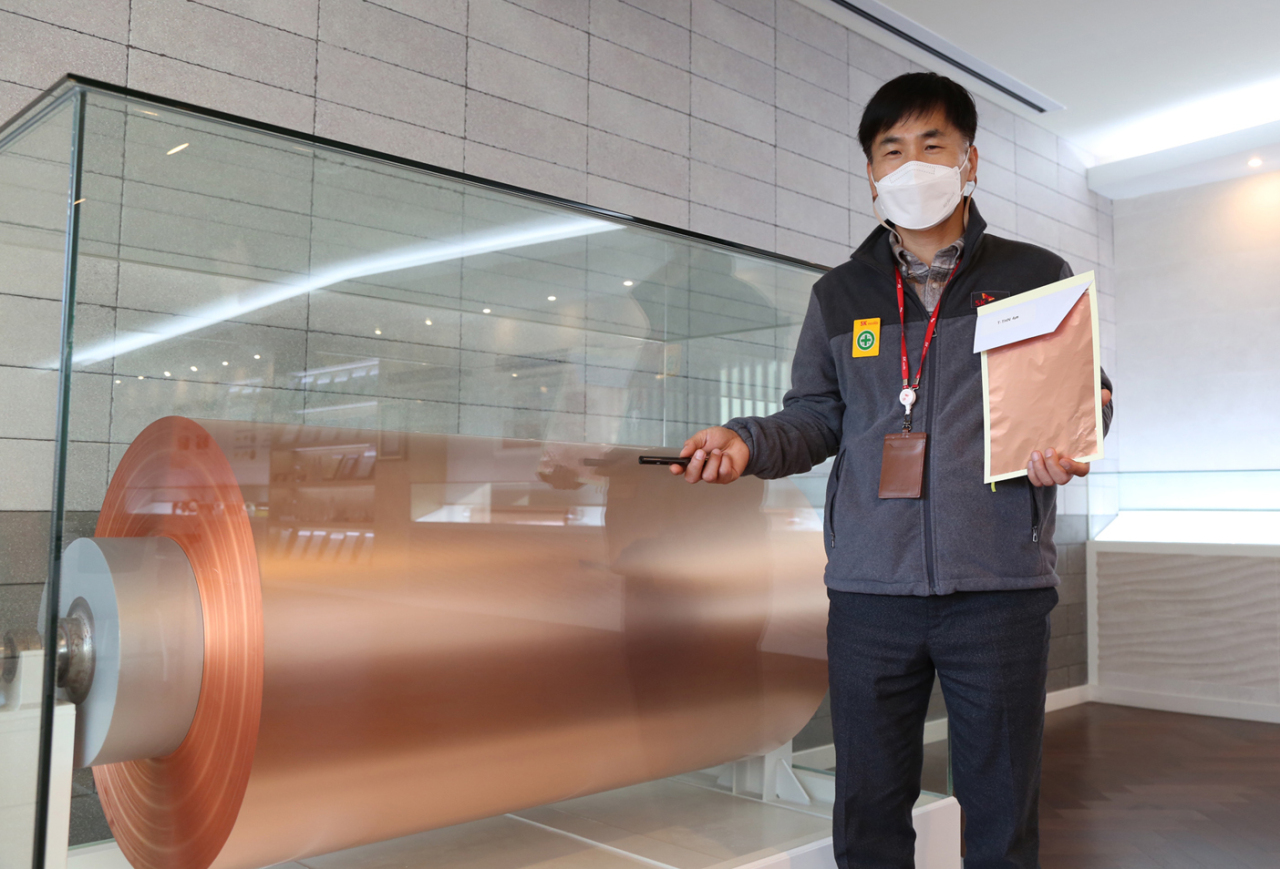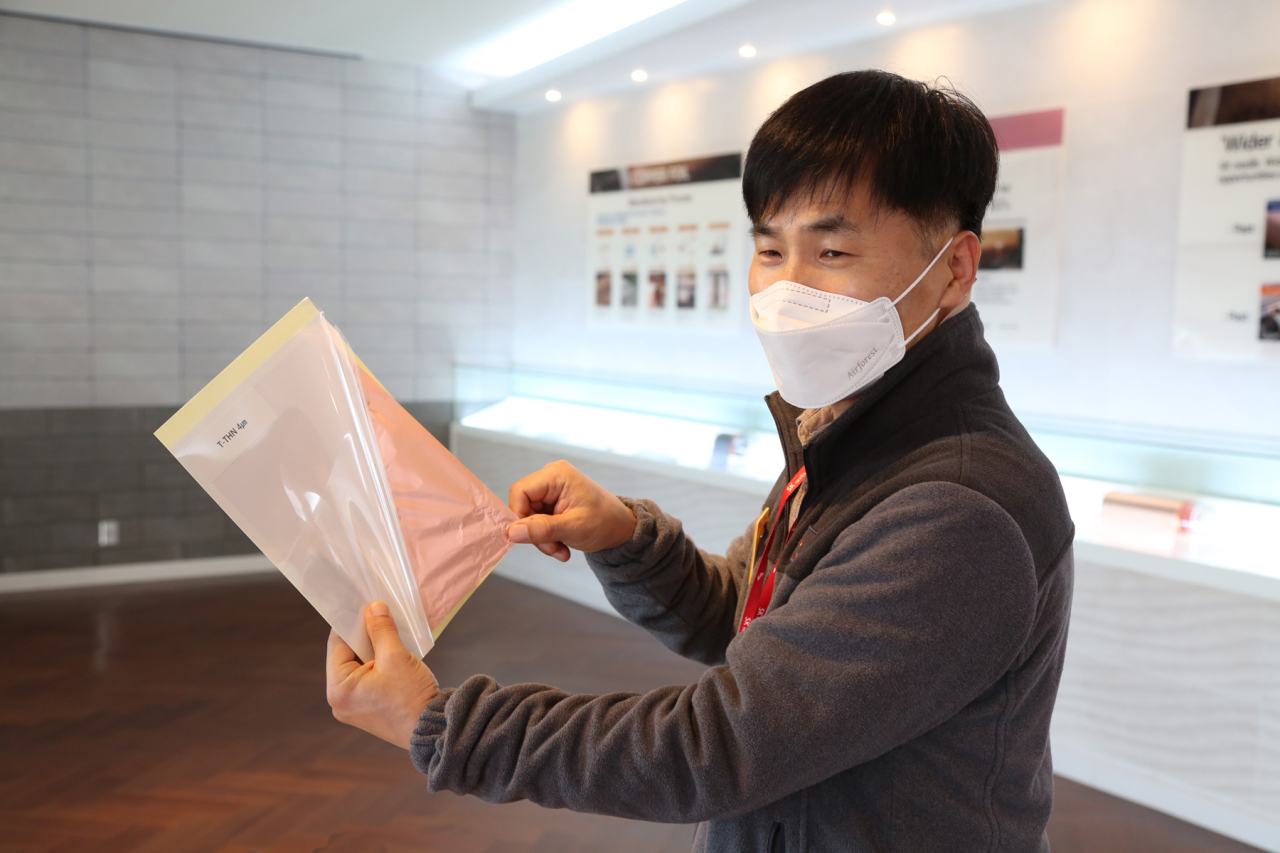 |
An SK Nexilis official briefs reporters on the company’s copper foil for EVs that is 6 micrometers thin and 40 kilometers long during a press tour in Jeongeup, North Jeolla Province, Monday. (SK Nexilis) |
JEONGEUP, North Jeolla Province -- On a cold, grey cement floor lay four rows of giant circular lids that could easily measure 5 meters in diameter.
The only things moving inside the shabby, dimly-lit warehouse were plastic fans ventilating the facility, which was lit by sunlight coming through the square window panes right beneath the high-rise ceiling.
The scene almost looked like a giant whack-a-mole machine.
But who could have imagined that under those enormous lids was the molten form of one of the most important raw ingredients used in electric vehicle batteries?
When reporters hopped out of a tour bus after a three-hour ride from Seoul to attend a press tour of copper foil factories located in Jeongeup, North Jeolla Province, Monday, they were greeted by officials from SK Nexilis, a wholly-owned copper foil subsidiary under SKC.
After arrival, reporters were first led to the facility. Inside those lids, high-grade copper wires were being dissolved in an acid to become liquid.
This copper liquid was then pumped into plant No. 3, where the containers that resembled bathtubs were installed.
Inside each of these tubs full of copper solution, a giant electrically charged titanium drum was partially submerged. These electrically charged drums triggered a chemical reaction with the copper solution, allowing a thin film of copper to stick and be coated on the surface of the drums. As these drums rotated, these thin films got thicker and thicker, until they became fat rolls.
The passionate pitch given by an SK Nexilis official reached a climax when reporters arrived at plant No. 4, which was the company’s most advanced and automated factory, where the temperature was kept at around at 25 degrees Celsius, because copper foils react sensitively to temperature and humidity.
“A roll of 6-micrometer copper foil with the width of 1.45 meter and the length of 70 kilometers weighs 5 tons. Due to the heavy weight, the roll has to be carried by a specially designed unmanned vehicle,” said the veteran official.
Despite the automation, more than 20 white safety helmets hanging at one side of the wall showed how much human labor played a critical role in the operation of the copper foil factory.
All in all, the two-hour press tour could be summed up into how thin, wide and long SK Nexilis could manufacture its copper foils compared to its competitors.
Currently, SK Nexilis supplies its 6-micrometer copper foils, which are 20 times thinner than a strand of hair, to six major EV battery manufacturers -- LG Chem, Samsung SDI, SK Innovation, Panasonic, CATL and AESC.
An anode, which accounts for a battery’s stability, is composed of copper foil coated with a graphite material. How well the copper foil bonds with the slurry of graphite coating determines the structural stability of a battery. Also, the copper foil serves as a path through which electrons travel. With high heat conductivity, the copper foil is a channel through which a battery releases heat generated from inside to the outside.
The thinner this copper foil is, the thicker the graphite coating can become, which translates to a greater energy density and lighter weight of the battery. According to SK Nexilis, when the thickness of copper foils is reduced from 8 micrometers to 4 micrometers, batteries become 3-5 percent lighter and 1-3 percent stronger.
Typically, copper foils take up 30 to 40 kilograms of the total weight of an EV.
But here’s the catch. No matter how thin SK Nexilis’ copper foils may be, they may be too thin for battery makers. According to SK Nexilis, the thinner the copper foils are, the more difficult it becomes for battery makers to handle them, which is why battery makers still use 6-micormeter copper foils even though there are thinner options available.
 |
An SK Nexilis official explains the technological details of the company’s 4-micrometer copper film for EVs that is 30 times thinner than a strand of hair.(SK Nexilis) |
SK Nexilis last year developed a 4-micrometer copper foil. However, the mass production of a 3-micrometer copper foil will require a completely different approach, said Jun Sang-hyun, head of production of SK Nexilis during a Q&A session.
Also, the longer the copper foil is, the fewer times battery makers have to replace used copper foil rolls with new ones, which is crucial for boosting productivity.
However, the longer the copper foil is, the heavier they become. Though a longer copper foil roll might save battery makers the trouble of changing the roll frequently, their facility must be strong enough to withstand the enormous weight.
Finally, according to SK Nexilis, though producing a copper foil with a greater width demands a more rigorous quality check to ensure consistency, the technology allows the company to print out more copper foils in the same amount of time.
Without giving a straight-forward response to questions regarding its patenting progress for its advanced technologies, SK Nexilis chief managing officer Yi Jae-hong said they were convinced battery makers will come along eventually. The current competition is Chinese copper foil makers who take advantage of cheaper labor costs and electricity to compensate for low productivity of shorter, narrow-width products.
SK Nexilis aims to strengthen its price competitiveness by constructing its first overseas production base in Southeast Asian countries where electricity is cheaper. According to Yi, the electricity price accounts for a substantial part of the total price.
 |
An SK Nexilis official briefs reporters on the progress of plant No.5, which is currently under construction. (SK Nexilis) |
SKC is currently constructing plant No.5 and No.6 simultaneously to ramp up the annual production capacity of SK Nexilis to 52,000 tons from the current 34,000. When combined with its foreign expansion plan, SK Nexilis will be equipped with a maximum production capacity of 136,000 tons by 2025.
Global demand for copper foils is expected to explode to 748,000 metric tons in 2025 from this year’s 135,000 tons, according to SNE Research.
Copper is almost four times more expensive than aluminum, which is why copper foils get more attention than aluminum foils, though both are crucial parts of EV batteries.
By Kim Byung-wook (
kbw@heraldcorp.com)










